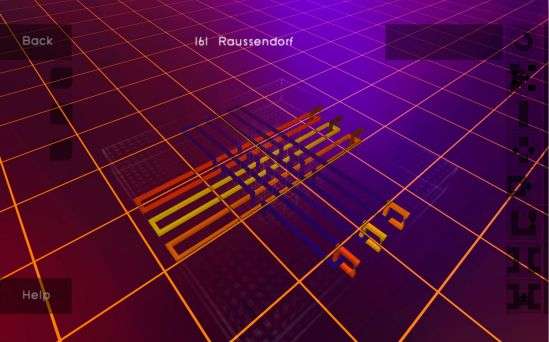October 10, 2016 weblog
MeQuanics: Let's play quantum computation for serious results

(Tech Xplore)—Can a 3-D puzzle become a favored tool of quantum software engineers? There is reason to hope for Japan-based Simon Devitt at the Center for Emergent Matter Science, Riken. Just play meQuanics, a 3-D puzzle game and he and colleagues will be very happy. The more players, the more hope they carry for their mission. (We will get to that in a minute.)
The game is hardly frivolous; it is based on the scientific principles governing quantum computation. This Web-based puzzle is called meQuanics. You can play the prototype version, available now. meQuanics.
Each puzzle in meQuanics represents a real quantum algorithm, "which needs to be optimized for a quantum computer to be realized with real quantum devices," said the project site.
"A fewer number of devices and a shorter run time increase our chance to build a real quantum computer. Reducing the resources necessary for a quantum computer is one of the most urgent and important problems to make this technology a reality."
Essentially, they are on a mission to gamify for useful results. "It's a bit buggy but it looks good and is worth a try if you have a few minutes," said MIT Technology Review. "MeQuanics is important—the process of playing the game creates a database of examples that can be used to train a machine."
You can read more about this and the thinking behind it in the paper, "Programming quantum computers using 3-D puzzles, coffee cups, and doughnuts" by Simon Devitt, which is now up on arXiv. The article appeared in the Fall 2016 issue of ACM-XRDS. The reference list in this arXiv version was expanded.
He wrote: " An initial prototype of a platform we have dubbed meQuanics [www.mequanics.com.au], designed to convert the topological optimization problem into a simple 3-D puzzle game, has been released online. Designed for touch-based platforms such as smartphones and tablet devices, meQuanics creates an online social media environment."
Point is, this is where the public gets to lend a hand in finding "small volume solutions to various quantum sub-circuits that are critical for largescale quantum computation."
The project site said that meQuanics will be further developed "into a real game to help us program quantum computers."
MIT Technology Review said, "One way to think about a quantum program is as a two-dimensional lattice of qubits, like a sheet, or a three-dimensional lattice, like a crystal. Information is encoded by creating a hole or defect in the lattice." Where Devitt steps in: he developed a "powerful way to visualize quantum programs as 3-D lattices with interlocking sections representing the way information is stored and processed," said MIT Technology Review.
In the bigger picture, Devitt wrote that "Quantum information technology is currently experiencing a second renaissance in advancement and investment from both the public and private sectors. As such, there is consensus amongst experts that it is no longer a question of if a large-scale quantum computer can be built, but when."
More information: Programming quantum computers using 3-D puzzles, coffee cups, and doughnuts, arXiv:1609.06628 [quant-ph] arxiv.org/abs/1609.06628
Abstract
The task of programming a quantum computer is just as strange as quantum mechanics itself. But it now looks like a simple 3D puzzle may be the future tool of quantum software engineers.
© 2016 Tech Xplore



















